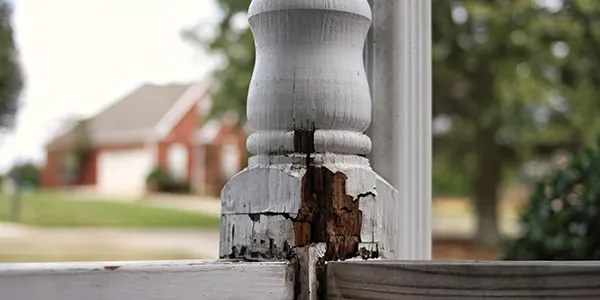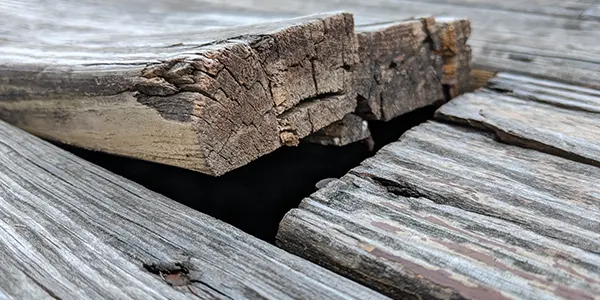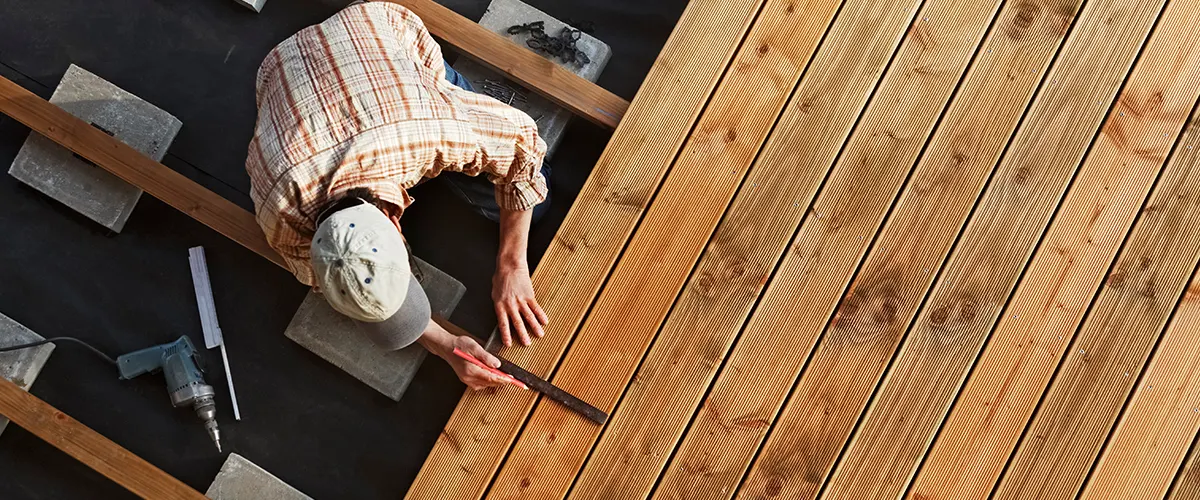
If you’re like most homeowners, you probably take great pride in your house and want to ensure it’s well-maintained. One part of your house that may need some attention is your front porch decking. If your porch decking is starting to show signs of wear and tear, or if it’s been damaged by weather, don’t worry – we’re here to help.
In this blog post, we’ll discuss the best material to use for decking, how to replace it, and how a home improvement project can change your house’s look. We’ll also provide some cost estimates to see just how affordable repairing your porch can be.
Are you in need of a wooden porch repair? Keep reading for tips and advice that will help you restore your porch to its former glory.
Porch foundation problems and how can they be fixed?

Rotting

Splintering

Warping
- Replace any rotted or damaged board
- Sand down any rough patches
- Repair any cracks or splits
- Seal the deck with a wood sealant
Choosing a material for front porch decking
You can use several different materials for front decking, but the most popular option is wood. Wood is a natural material that adds a touch of elegance to any porch, and it’s also durable and long-lasting. If your porch starts to show signs of wear, wooden porch repair can easily restore its original charm.
If you’re looking for more options that make sense to your budget, composite decking is a good choice. Composite decking is made from recycled materials, so it’s environmentally friendly. It’s also resistant to weather damage and insects, making it an excellent choice for decks exposed to the elements.
Finally, if you’re looking for a durable option, metal decking is a good choice. Metal decking is resistant to moisture and insects, and it doesn’t rot or warp as wood decking can. However, it’s important to note that metal decking can be pretty expensive compared to other materials.

Wooden Porch Repair: How To Guide
The porch deck is the foundation of any house. It’s where you greet guests and take in the sunsets with a glass of lemonade. After years of weathering, even the sturdiest porches can show their age. It is not an easy task and is best left to professionals, as it may pose safety risks both to you and the people who will step on it in the future.

Step 1: Assess the Damage
Start by thoroughly inspecting your deck for any signs of damage such as rotting wood, loose boards, or rusted nails. Identifying specific areas needing repair helps you formulate an effective plan.
A detailed inspection ensures you don’t overlook minor issues that could become major problems later. Create a checklist to systematically identify all areas that require attention, which will make the repair process smoother.
Step 2: Gather Necessary Tools and Materials
Collect all the tools and materials you’ll need for the repair. Essential items include a pry bar, hammer, replacement boards, screws, and wood sealant. Having everything on hand streamlines the process.
Preparing your tools and materials in advance prevents interruptions and delays. It allows you to focus on the repair work, making the entire process more efficient and less stressful.
Step 3: Remove Damaged Boards
Once you’ve identified the damaged sections, carefully use a pry bar to lift and remove them. Be cautious not to disturb the surrounding boards to maintain the structural integrity of the deck.
Taking your time during this step ensures you don’t accidentally damage adjacent boards. Proper removal techniques help preserve the overall stability and appearance of your deck, making replacement easier.
Step 4: Replace with New Boards
Cut the replacement boards to the correct size, ensuring they fit snugly into the gaps left by the removed ones. Secure them in place with screws or nails, making sure they are flush with the existing surface.
This step requires precision to ensure a smooth, safe deck surface. Accurate measurements and secure fastening keep the deck looking uniform and structurally sound, preventing future issues.
Step 5: Seal and Maintain
After completing the repairs, apply a protective wood sealant to all surfaces. This is crucial for extending the life of your deck and preventing future damage from moisture, sunlight, and pests.
Regular maintenance, including sealing, helps keep your deck in top condition. It protects against environmental damage and wear, ensuring your deck remains a valuable and enjoyable outdoor space.
6. Seal and stain
Tips to make your repair last longer
Use premium materials
When choosing materials for your decking, be sure to select high-quality products. This ensures that the new deck board lasts longer and doesn’t show signs of wear and tear as quickly.
Seal the deck
Keep it clean
How much does it cost to repair a porch?
If you’re looking to repair a porch, there are a few things you’ll need to take into account. First, you’ll need to determine the extent of the damage and whether or not the porch is worth repairing, especially when attached to an old house. For instance, are you considering a wooden porch repair?
If the damage is minor, you may be able to do the repairs yourself. However, if the damage is more extensive, you may need to hire a professional contractor. Another thing to consider is the type of material the porch is made from. If the porch is made from wood, you’ll need to replace any damaged boards and fix any rotted areas. If the porch is made from metal, you won’t have to worry about rot, but you may need to seal and protect the decking from weathering.
The cost of repairing a porch can vary depending on the size and extent of the damage. However, you can expect to pay between $100 and $500 for repairs. If the damage is more extensive, the cost may be higher. It’s always best to get a quote from a contractor before starting any repairs.

When should you replace a porch?
- The structure is unsafe and needs to be fixed immediately when attached to an old house
- The porch is not up to code
- The decking or flooring is rotting and needs to be replaced
- The porch railing is damaged or broken
- The steps are loose or wobbly
- The porch roof is leaking
- A storm or flood has damaged the porch
- The porch columns are starting to rot
- The board's edges are uneven and damaged
- The board pops loose
If you are experiencing any of these problems, then it’s time to replace your porch. Contact a professional contractor for help. They will be able to assess the damage and give you a quote for the cost of replacement.
Replacing a porch can be expensive, but it is a necessary investment that will increase the value of your house. Make sure to choose a contractor you can trust, and that has experience in porch replacement.

Additional advice to keep your decking brand new
Replacing the decking on your front porch is a big job, but it can be done quickly if you have the right materials and know what you’re doing. Let us give you some tips on keeping it looking new for years to come.
Here are a few additional tips to help keep your deck boards looking new:
- Keep the area clean and free of debris
- Avoid rotting outdoor flooring
- Sweep the deck regularly to remove any dirt or dust
- Apply a wood sealant and oil-based primer every few years to protect the new decking from the elements
- Replace any old boards or railings immediately
- Inspect the porch for any signs of damage regularly and repair as necessary
- Take care of porch posts and wood columns

Conclusion
Your porch’s new decking is an integral part of your property— it’s what you come home to every day. Whether the wood siding has lost its color or fallen apart after years of rain and snow, DeckBros can help restore that welcoming feel with a full-service porch repair in Omaha, NE.
From replacing rotting boards to removing stains from decks, our team will take care of the work, so all you have to do is enjoy! If this sounds like something up your alley, but you need more information about when to replace your current porch decking before starting repairs, contact us today for an estimate on any size project.
